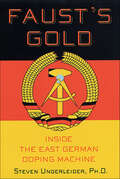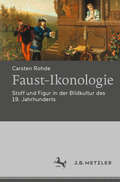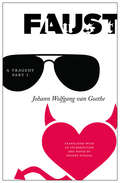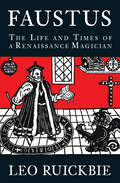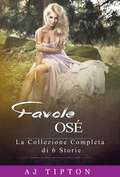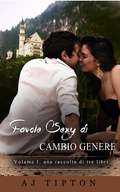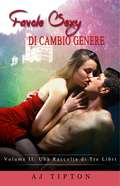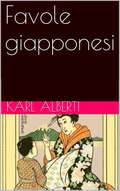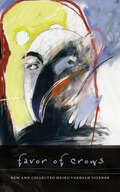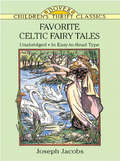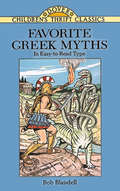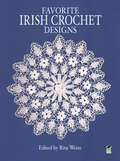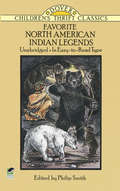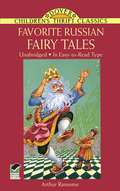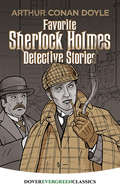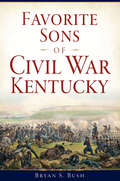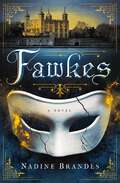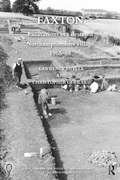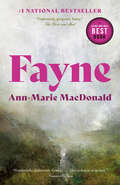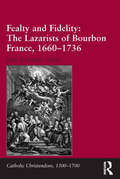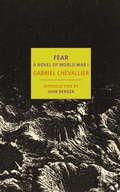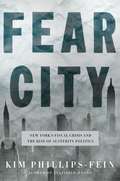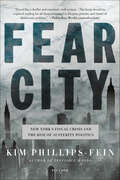- Table View
- List View
Faust's Gold: Inside the East German Doping Machine
by Steven UngerleiderSteven Ungerleider's Faust's Gold is the stunning expose of the East German sports juggernaut of the 1970s and 1980s that forced young athletes to unknowingly take steroids. For nearly twenty-five years, East Germany's corrupt sports organization dominated international athletics. While the German Democratic Republic's secret "State Plan" was in effect, more than ten thousand unsuspecting young athletes--some as young as twelve years old--were given massive doses of performance-enhancing anabolic steroids. These athletes achieved miraculous success in international competitions, including the Olympics, but for many of them, their physical and emotional health was permanently damaged.Faust's Gold draws on the revelations of the ongoing trials of former GDR coaches, doctors, and sports officials who have now confessed to conducting ruthless medical experiments on young and talented athletes selected for Olympic training camps. It also draws on the extensive research of Brigitte Berendonk, who escaped from East Germany to begin a decade-long crusade to bring justice to her fellow athletes, and that of her husband, Professor Werner Franke. Berendonk's story, and those of her colleagues in the GDR, offers a unique insight into a bizarre regime.Faust's Gold is a true-life detective story that plunges into the dark, secretive world of the GDR doping scam, where elite competitors and their families are up against a formidable opponent: the East German secret police, known as the STASI. What emerges is a complex tapestry of the politicized modern Olympics that culminates in a powerful testimony to the massive wrong done by one Eastern Bloc nation to its world-class athletes.
Faust-Ikonologie: Stoff und Figur in der Bildkultur des 19. Jahrhunderts
by Carsten RohdeDie Geschichte des Faust-Stoffes seit Goethe ist lange Zeit vor allem unter ideologischen Gesichtspunkten gedeutet worden. Die vorliegende Studie untersucht erstmals tiefergehend die populärkulturellen Resonanzen von Faust in der sich formierenden Medienmoderne des 19. Jahrhunderts. Die ‚Explosion der Bilder‘ sorgt dafür, dass Stoff und Figur in einer nie dagewesenen Vielfalt und Breite als visuelles Phänomen in Erscheinung treten. Faust wird zu einer populären Projektions- und Identifikationsfigur, die mit ganz unterschiedlichen Formen, Funktionen und Kontexten in Verbindung steht. Ihre Omnipräsenz in der Bildkultur des Jahrhunderts ist sowohl Spiegel als auch Katalysator dieser Entwicklungen.
Faust: A Tragedy, Part I
by Eugene Stelzig Johann Wolfgang van GoetheGoethe is the most famous German author, and the poetic drama Faust, Part I (1808) is his best-known work, one that stands in the company of other leading canonical works of European literature such as Dante’s Inferno and Shakespeare’s Hamlet. This is the first new translation into English since David Constantine’s 2005 version. Why another translation when there are several currently in print? To invoke Goethe’s own authority when speaking of his favorite author, Shakespeare, Goethe asserts that so much has already been said about the poet-dramatist “that it would seem there’s nothing left to say,” but adds, “yet it is the peculiar attribute of the spirit that it constantly motivates the spirit.” Goethe’s great dramatic poem continues to speak to us in new ways as we and our world continually change, and thus a new or updated translation is always necessary to bring to light Faust’s almost inexhaustible, mysterious, and enchanting poetic and cultural power. Eugene Stelzig’s new translation renders the text of the play in clear and crisp English for a contemporary undergraduate audience while at the same time maintaining its leading poetic features, including the use of rhyme. Published by Bucknell University Press. Distributed worldwide by Rutgers University Press.
Faustus: The Life and Times of a Renaissance Magician
by Leo RuickbieFive hundred years ago the legend was born of a man who sold his soul to the Devil for power, wealth and women. It is a legend that has inspired genius and still inspires high art and popular culture alike. Around the world there are hundreds of nightly performances of Geothe's Faust, as well as actual attempts at soul-selling on eBay. Faustus has rightly been described as an 'icon of modern culture'. But in 500 years no one has written his biography - until now. 'Faustus' is the real story behind the legend. It is the story of a sixteenth-century scandal, of a man who claimed mastery of the forbidden magical arts and dared to rival the miracles attributed to Jesus. he evoked uproar and was accused of heinous crimes. But Faustus was not a charlatan; nor was he in league with the Devil. To find the real Faustus is to find the true history of his age, and Leo Ruickbe expertly takes the reader on a tour of war-torn Italy, Reformation Wittenberg and the magnificence of Charles V's court. The life of the legend becomes as real as any living person.
Favole Osé: La Collezione Completa di 6 Storie
by Aj Tipton Benedetta A.Le favole come non le avete mai viste prima. In un magico regno lontano, vivevano principi maledetti, donne guerriere e potenti magie. Questa collezione di sei libri comprende le rivisitazioni sexy di cambio genere delle favole classiche: Cenerentola, Cappuccetto Rosso, La Bella Addormentata, La Bella e la Bestia, Biancaneve, e Raperonzolo. Gli eroi sono diventati eroine, le eroine sono diventate eroi, e niente è come sembra. Ciò Che Vuole la Regina. In questo racconto poliamoroso FFM di seduzione, liberazione, e sconosciuti inebrianti, anche il più umile dei contadini ha una chance con ciò che vuole la Regina. A Caccia di Red. Questa storia matura include coraggiosi combattimenti di spade, tempestosi rapporti sessuali, ed una cattiva in cui vorrete affondare i denti. Spezzando la Maledizione: il compagno reale di Raven. Questa spinta rivisitazione de La Bella Addormentata include leggero bondage, stregoni ubriachi, ed un amore abbastanza forte da sconfiggere la magia. Il Bello e la Bestia: Questa favola di cambio genere per adulti include cose a tre sexy FFM, trasformazioni bestiali, ed una storia senza tempo. Il Vero Amore di Neve: Questo romanzo per adulti include avventure sexy, nane esuberanti, e l’amore più bello di sempre. Chioma Apparente: Questa favoletta sexy per adulti include peripezie ad alto rischio, creature pericolose che fanno giochi di parole, ed un amore che nemmeno la magia può prevedere. Questi libri AUTONOMI possono essere letti in qualsiasi ordine. Non ci sono finali in sospeso, ed ognuno finisce come dovrebbe: per sempre felici e contenti.
Favole Sexy di Cambio Genere Volume I: una raccolta di tre libri
by Aj TiptonCenerentola, Cappuccetto Rosso e La Bella Addormentata come non li avete mai visti prima. In un magico regno lontano, vivevano principi maledetti, donne guerriere e potenti eroi. Questa raccolta di tre libri si distingue per la rivisitazione sexy di cambio genere delle favole classiche: Cenerentola, Cappuccetto Rosso e La Bella Addormentata. Gli eroi sono diventati eroine, e niente è come sembra. Ciò che vuole la Regina. In questo racconto FFM poliamoroso di seduzione, liberazione, e sconosciuti inebrianti, anche il più umile dei contadini ha una chance se è ciò che vuole la Regina. A caccia di Red. Questa storia matura include coraggiosi combattimenti di spade, tempestosi rapporti sessuali, ed una cattiva in cui vorrete affondare i denti. Spezzando la Maledizione: il compagno reale di Raven. Questa spinta rivisitazione de La Bella Addormentata include leggero bondage, stregoni ubriachi, ed un amore abbastanza forte da sconfiggere la magia. Queste favole AUTONOME possono essere lette in ogni ordine. Non ci sono finali in sospeso, ed ognuna finisce come dovrebbe: per sempre felici e contenti.
Favole Sexy di Cambio Genere Volume II: una raccolta di tre libri
by Aj Tipton Benedetta A.La Bella e la Bestia, Biancaneve, e Raperonzolo come non li avete mai visti prima. In un magico regno lontano, vivevano principi maledetti, donne guerriere e potenti magie. Questa raccolta di tre libri comprende le rivisitazioni sexy di cambio genere delle favole classiche: La Bella e la Bestia, Biancaneve, e Raperonzolo. Gli eroi sono diventati eroine, le eroine sono diventate eroi, e niente è come sembra. Il Bello e la Bestia. Questa favola di cambio genere per adulti include cose a tre sexy FFM, trasformazioni bestiali, ed una storia senza tempo. Il Vero Amore di Neve. Questo romanzo per adulti include avventure sexy, nane esuberanti, e l’amore più bello di sempre. Chioma Apparente. Questa favoletta sexy per adulti include peripezie ad alto rischio, creature pericolose che fanno giochi di parole, ed un amore che nemmeno la magia può prevedere. Questi libri AUTONOMI possono essere letti in qualsiasi ordine. Non ci sono finali in sospeso, ed ognuno finisce come dovrebbe: per sempre felici e contenti.
Favole giapponesi
by Karl Alberti SilviaIn questo libro è contenuta una raccolta di ventiquattro favole, molte delle quali non sono mai state tradotte prima dal giapponese.
Favor of Crows: New and Collected Haiku (Wesleyan Poetry Series)
by Gerald VizenorA collection of original haiku from a preeminent Native American poet and novelist. Favor of Crows is a collection of new and previously published original haiku poems over the past forty years. Gerald Vizenor has earned a wide and devoted audience for his poetry. In the introductory essay the author compares the imagistic poise of haiku with the early dream songs of the Anishinaabe, or Chippewa. Vizenor concentrates on these two artistic traditions, and by intuition he creates a union of vision, perception, and natural motion in concise poems; he creates a sense of presence and at the same time a naturalistic trace of impermanence. The haiku scenes in Favor of Crows are presented in chapters of the four seasons, the natural metaphors of human experience in the tradition of haiku in Japan. Vizenor honors the traditional practice and clever tease of haiku, and conveys his appreciation of Matsuo Basho and Yosa Buson in these two haiku scenes, "calm in the storm / master basho soaks his feet /water striders," and "cold rain / field mice rattle the dishes / buson's koto." Vizenor is inspired by the sway of concise poetic images, natural motion, and by the transient nature of the seasons in native dream songs and haiku. "The heart of haiku is a tease of nature, a concise, intuitive, and an original moment of perception," he declares in the introduction to Favor of Crows. "Haiku is visionary, a timely meditation and an ironic manner of creation. That sense of natural motion in a haiku scene is a wonder, the catch of impermanence in the seasons." Check for the online reader's companion at favorofcrows.site.wesleyan.edu.
Favorite Celtic Fairy Tales (Dover Children's Thrift Classics)
by Joseph JacobsExperience the whimsy, charm and magic of the Celtic imagination in this captivating collection of timeless stories that have enchanted generations of youngsters and adults.Among the eight popular tales included here are "The Fate of the Children of Lir," a haunting narrative of four children turned into swans by a wicked stepmother; "The Shepherd of Myddvai," in which a beautiful woman, risen from the sea, orders her husband-to-be to observe certain rules; and "Beth Gellert," a touching tale of a brave dog that dies after saving a child's life. Five additional stories include "The Tale of Ivan," "Morraha," "The Story of Deirdre," "The Llanfabon Changeling," and "The Sea-Maiden."Reset in large, easy-to-read type, these engaging stories are enhanced by six new illustrations.
Favorite Greek Myths (Dover Children's Thrift Classics Ser.)
by Bob BlaisdellThe Greek myths have intrigued countless generations of readers with their exciting tales of adventure, calamity, and conquest. This entertaining collection -- excellently retold for young audiences by Bob Blaisdell -- invites children to relive the memorable experiences of familiar characters from Greek mythology.Taken directly from the writings of Homer, Hesiod, Sophocles, Aeschylus, Euripides, and other ancient storytellers, the myths recount the stirring and imaginative tales of Pandora's box, Prometheus, the dreaded Cyclops, the labors of the mighty Hercules, the captivating stories of Narcissus and Echo, Aphrodite and Eros, Daedalus and Icarus, Hades and Persephone, and many more.Set in large, easy-to-read type and enhanced by six full-page black-and-white illustrations, these enduring fables from the fountainhead of Western civilization will thrill and delight new generations of adventure-seekers.
Favorite Irish Crochet Designs
by Rita WeissCreate airy and delicate lace designs for table, bed, and wardrobe using the time-honored technique of Irish crochet. This handsome handicraft, known for its raised floral motifs and intricate background patterns, probably originated in the convents of Ireland, where diligent nuns prepared beautiful ornaments for use in church services. Today, this stunning form of lace-making has been adapted and simplified for dozens of day-to-day uses: decorating curtains, tablecloths, pillows, bedspreads, lingerie, collars, children's clothing, doilies, and more.Rita Weiss, a noted needlework designer and bestselling author, has collected the finest, easily workable examples of Irish crochet from rare American thread company booklets of more than 50 years ago. Step-by-step instructions, stitch and hook charts, metric conversion charts, and 40 clear illustrations allow you to make magnificent accessories in these lovely patterns: My Wild Irish Rose, Popcorn, Rose of Sharon, Cinderella, More Than a Touch of Blarney, Beauty Rose, "Smilin' Through," Tournament of Roses, Wedding Ring, Dublin Beauty, Irish Springtime, and others. No skills beyond a familiarity with ordinary crochet technique are needed to create these beautiful patterns. In addition, expert tips on blocking and finishing make it certain that your final product will be nothing short of a work of art.With this versatile, inexpensive guide, the beauty of Irish crochet -- once thought too difficult to achieve by any but the most experienced needleworkers -- is now within reach of even beginning crocheters.
Favorite North American Indian Legends (Dover Children's Thrift Classics)
by Philip SmithHere is a treasury of charming tales brimming with the humor, whimsy and imagination characteristic of Native American folklore. Specially chosen from children, the stories include an Algonquin tale of how Glooskap conquered the Great Bull-Frog, and how pollywogs, crabs, leeches, and other water creatures were created; "The Meeting of the Wild Animals," a Tsimshian myth recounting how the four seasons came into being and why all animals are afraid of the porcupine; "The Bear Man," a Cherokee legend about a hunter who lived with her prey; and "The Man Who Married the Moon," a Pueblo tale of a great chief, his beautiful wife, and the treachery of two evil corn maidens.These and nine other authentic tales offer a wealth of reading entertainment as well as insight into American Indian life and culture. Six new full-page illustrations by Thea Kliros enhance the text, printed in large, easy-to-read type.
Favorite Russian Fairy Tales (Dover Children's Thrift Classics)
by Arthur RansomeRussian folk culture is filled with magical stories for children; tales of witches and wizardry, perilous journeys, wise animals, frightful giants, and beautiful princesses. This choice collection presents six of the most popular tales. Some bear a resemblance to the folktales of western Europe, while others introduce exotic creatures and situations unique to the Russian imagination. Among the fanciful characters young readers will encounter in these stories are the legendary Fire-bird; the dulcimer-playing Sadko, whose music could make the Tzar of the Sea dance; the iron-toothed witch Baba Yaga, and many more.British author Arthur Ransome (1884-1967) gathered these authentic tales from peasant storytellers on his journeys to Russia early in the twentieth century. He then retold them in English. This volume reproduces the English versions, reset in large, easy-to-read type, and illustrated with six handsome new drawings.
Favorite Sherlock Holmes Detective Stories (Dover Children's Evergreen Classics)
by Sir Arthur Conan DoyleThroughout the annals of literature there is one detective who reigns supreme -- Mr. Sherlock Holmes of 221B Baker Street, London. From that celebrated address, Holmes and his friend Dr. Watson set out to solve the most difficult cases and bring to justice the master criminals of Victorian England.Now readers can enjoy the crime-solving exploits of the storied duo in this selection of favorite adventures. "The Adventure of the Dancing Men" concerns the appearance of mysterious stick-figure drawings, which prove disastrous to a country squire and his bride; "The Red-Headed League" pits Holmes against a clever bank robber, while "A Scandal in Bohemia" finds the detective locked in cerebral combat with Irene Adler, the only female who ever outwitted him (and the only one to steal his heart). In "The Final Problem" Holmes confronts the evil Professor Moriarty, "the Napoleon of Crime," atop the Reichenbach Falls. Also included here are four other classic tales: "Silver Blaze," "The Adventure of the Speckled Band," "The Engineer's Thumb," and "The Crooked Man."A great way to introduce younger readers to the world's best-known fictional detective, this affordable collection will entertain mystery lovers of all ages.
Favorite Sons of Civil War Kentucky (Civil War Series)
by Bryan S. BushWhen the Civil War broke out, thousands of Kentuckians struggled to maintain the state’s neutrality in deciding which side to support. Although Kentucky was a slaveholding state, most of the population did not wish to secede from the Union. More than 140,000 Kentucky solders fought on both sides, in the Eastern and Western Theaters. Some of those who emerged from these battlegrounds are among the state’s favorite local heroes. Join historian and author Bryan S. Bush as he recounts the journeys of these brave men who fought to build and maintain the legacy of the Bluegrass State.
Fawkes: A Novel
by Nadine Brandes“Fawkes is the perfect mix of history and magic.” —Cynthia Hand, New York Times bestselling author of My Lady JaneThomas Fawkes is turning to stone, and the only cure to the Stone Plague is to join his father’s plot to assassinate the king of England.Silent wars leave the most carnage. The wars that are never declared but are carried out in dark alleys with masks and hidden knives. Wars where color power alters the natural rhythm of 17th-century London. And when the king calls for peace, no one listens until he finally calls for death.But what if death finds him first?Keepers think the Igniters caused the plague. Igniters think the Keepers did it. But all Thomas knows is that the Stone Plague infecting his eye is spreading. And if he doesn’t do something soon, he’ll be a lifeless statue. So when his Keeper father, Guy Fawkes, invites him to join the Gunpowder Plot—claiming it will put an end to the plague—Thomas is in.The plan: use 36 barrels of gunpowder to blow up the Igniter King.The problem: Doing so will destroy the family of the girl Thomas loves. But backing out of the plot will send his father and the other plotters to the gallows. To save one, Thomas will lose the other.No matter Thomas’s choice, one thing is clear: once the decision is made and the color masks have been put on, there’s no turning back.“I was up late in the night reading, waiting to get to the fifth of November to see how the plot would actually unfold, and it did not disappoint. An imaginative, colorful tale about choosing for yourself between what’s right and what others insist is the truth.” —Cynthia Hand, New York Times bestselling author of My Lady Jane“Hold on to your heart as this slow-burning adventure quickly escalates into an explosion of magic, love, and the truth about loyalty.” —Mary Weber, bestselling author of the Storm Siren Trilogy“Fawkes is a tale full of spiritual depth, tragedy, and hope. A beautifully written allegory for the magic of faith, with an achingly relatable hero who pulls you into his world heart and soul. A must-read for all fantasy fans!” —Lorie Langdon, author of Olivia Twist“A brilliant book that fulfills every expectation. Brandes turns seventeenth century London into a magical place. I was captivated by the allegory of her magic system and how she blended that fantasy with history. I highly recommend this gripping and beautifully crafted book to all. It will leave you both entertained and pondering matters raised in the storyline long after you’ve finished reading.” —Jill Williamson, Christy Award-winning author of By Darkness Hid and Captives“A magical retelling of the seventeenth century’s famous Gunpowder Plot that will sweep you back in time—to a divided England where plagues can turn you to stone and magic has a voice. Deft and clever, Fawkes is a vibrant story about the search for truth and issues relevant to us, still, today.” —Tosca Lee, New York Times bestselling author
Fawn
by Robert PeckA young French Mohawk halfbreed, refusing allegiance to any group or convention, is fatefully caught up in the 1758 battle between British and Mohawks and French and Hurons for Fort Ticonderoga.
Faxed: The Rise and Fall of the Fax Machine (Johns Hopkins Studies in the History of Technology)
by Jonathan CoopersmithThe intriguing story of the rise and fall—and unexpected persistence—of the fax machine illustrates the close link between technology and culture.Co-Winner of the Hagley Prize in Business History of the Business History ConferenceFaxed is the first history of the facsimile machine—the most famous recent example of a tool made obsolete by relentless technological innovation. Jonathan Coopersmith recounts the multigenerational, multinational history of the device from its origins to its workplace glory days, in the process revealing how it helped create the accelerated communications, information flow, and vibrant visual culture that characterize our contemporary world.Most people assume that the fax machine originated in the computer and electronics revolution of the late twentieth century, but it was actually invented in 1843. Almost 150 years passed between the fax’s invention in England and its widespread adoption in tech-savvy Japan, where it still enjoys a surprising popularity. Over and over again, faxing’s promise to deliver messages instantaneously paled before easier, less expensive modes of communication: first telegraphy, then radio and television, and finally digitalization in the form of email, the World Wide Web, and cell phones. By 2010, faxing had largely disappeared, having fallen victim to the same technological and economic processes that had created it. Based on archival research and interviews spanning two centuries and three continents, Coopersmith’s book recovers the lost history of a once-ubiquitous technology. Written in accessible language that should appeal to engineers and policymakers as well as historians, Faxed explores themes of technology push and market pull, user-based innovation, and "blackboxing" (the packaging of complex skills and technologies into packages designed for novices) while revealing the inventions inspired by the fax, how the demand for fax machines eventually caught up with their availability, and why subsequent shifts in user preferences rendered them mostly passé.
Faxton: Excavations in a deserted Northamptonshire village 1966–68 (The Society for Medieval Archaeology Monographs)
by Lawrence ButlerThe village of Faxton in Northamptonshire was only finally deserted in the second half of the 20th century. Shortly afterwards, between 1966 and 1968, its medieval crofts were investigated under the direction of archaeologist Lawrence Butler. At the time this was one of the most ambitious excavations of a deserted medieval settlement to have been conducted and, although the results were only published as interim reports and summaries, Butler’s observations at Faxton were to have significant influence on the growing academic and popular literature about village origins and desertion and the nature of medieval peasant crofts and buildings. In contrast to regions with abundant building stone, Faxton revealed archaeological evidence of a long tradition of earthen architecture in which so-called ‘mud-walling’ was successfully combined with other structural materials. The ‘rescue’ excavations at Faxton were originally promoted by the Deserted Medieval Village Research Group and funded by the Ministry of Public Buildings and Works after the extensive earthworks at the site came under threat from agriculture. Three areas were excavated covering seven crofts. In 1966 Croft 29 at the south-east corner of the village green revealed a single croft in detail with its barns, yards and corn driers; in 1967 four crofts were examined together in the north-west corner of the village in an area badly damaged by recent ploughing and, finally, an area immediately east of the church was opened up in 1968. In all, some 4000m2 were investigated in 140 days over three seasons. The post-excavation process for Faxton was beset by delay. Of the 12 chapters presented in this monograph, only two were substantially complete at the time of the director’s death in 2014. The others have had to be pieced together from interim summaries, partial manuscripts, sound recordings, handwritten notes and on-site records. Building on this evidence, a new team of scholars have re-considered the findings in order to set the excavations at Faxton into the wider context of modern research. Their texts reflect on the settlement’s disputed pre-Conquest origins, probable later re-planning and expansion, the reasons behind the decline and abandonment of the village, the extraordinary story behind the destruction of its church, the development of the open fields and the enclosure process, as well as new evidence about Faxton’s buildings and the finds discovered there. Once lauded, then forgotten, the excavations at Faxton now make a new contribution to our knowledge of medieval life and landscape in the East Midlands.
Fayne: A Novel
by Ann-Marie MacDonaldTHE INSTANT #1 NATIONAL BESTSELLERWINNER OF THE 2023 PARAGRAPHE HUGH MACLENNAN PRIZE FOR FICTIONA GLOBE AND MAIL BEST BOOK OF THE YEARONE OF CBC&’S BEST CANADIAN FICTION BOOKS OF 2022A beloved writer returns with a tale of science, magic, love and identity.In the late nineteenth century, Charlotte Bell is growing up at Fayne, a vast and lonely estate straddling the border between England and Scotland, where she has been kept from the world by her adoring father, Lord Henry Bell, owing to a mysterious condition. Charlotte, strong and insatiably curious, revels in the moorlands, and has learned the treacherous and healing ways of the bog from the old hired man, Byrn, whose own origins are shrouded in mystery. Her idyllic existence is shadowed by the magnificent portrait on the landing in Fayne House which depicts her mother, a beautiful Irish-American heiress, holding Charlotte&’s brother, Charles Bell. Charlotte has grown up with the knowledge that her mother died in giving birth to her, and that her older brother, Charles, the long-awaited heir, died soon afterwards at the age of two. When Charlotte&’s appetite for learning threatens to exceed the bounds of the estate, her father breaks with tradition and hires a tutor to teach his daughter &“as you would my son, had I one.&” But when Charlotte and her tutor&’s explorations of the bog turn up an unexpected artefact, her father announces he has arranged for her to be cured of her condition, and her world is upended. Charlotte&’s passion for knowledge and adventure will take her to the bottom of family secrets and to the heart of her own identity.
Fealty and Fidelity: The Lazarists of Bourbon France, 1660-1736 (Catholic Christendom, 1300-1700)
by Seán Alexander SmithThe career of the French saint Vincent de Paul has attracted the attention of hundreds of authors since his death in 1660, but the fate of his legacy - entrusted to the body of priests called the Congregation of the Mission (Lazarists) - remains vastly neglected. De Paul spent a lifetime working for the reform of the clergy and the evangelization of the rural poor. After his death, his ethos was universally lauded as one of the most important elements in the regeneration of the French church, but what happened to this ethos after he died? This book provides a thorough examination of the major activities of de Paul’s immediate followers. It begins by analysing the unique model of religious life designed by de Paul - a model created in contradistinction to more worldly clerical institutes, above all the Society of Jesus. Before he died, de Paul made very clear that fidelity to this model demanded that his disciples avoid the corridors of power. However, this book follows the subsequent departures from this command to demonstrate that the Congregation became one of the most powerful orders in France. The book includes a study of the termination of the little-known Madagascar mission, which was closed in 1671. This mission, replete with colonial scandal and mismanagement, revealed the terrible pressures on de Paul’s followers in the decade after his demise. The end of the mission occasioned the first major reassessment of the Congregation’s goals as a missionary institute, and involved abandoning some of the goals the founder had nourished. The rest of the book reveals how the Lazarists recovered from the setbacks of Madagascar, famously becoming parish priests of Louis XIV at Versailles in 1672. From then on, fealty to Louis XIV gradually trumped fidelity to de Paul. The book also investigates the darker side of the Congregation’s novel alliance with the monarch, by examining its treatment of Huguenot prisoners at Marseille later in the century, and its involvement with the slave trade in the Indian Ocean. This study is a wide-ranging investigation of the Lazarists’ activities in the French Empire, ultimately concluding that they eclipsed the Society of Jesus. Finally, it contributes new information to the literature on Louis XIV’s prickly relationship with religious agents that will surprise historians working in this area.
Fear
by John Berger Malcolm Imrie Gabriel ChevallierAn NYRB Classics Original Winner of the Scott Moncrieff Prize for Translation1915: Jean Dartemont heads off to the Great War, an eager conscript. The only thing he fears is missing the action. Soon, however, the vaunted "war to end all wars" seems like a war that will never end: whether mired in the trenches or going over the top, Jean finds himself caught in the midst of an unimaginable, unceasing slaughter. After he is wounded, he returns from the front to discover a world where no one knows or wants to know any of this. Both the public and the authorities go on talking about heroes--and sending more men to their graves. But Jean refuses to keep silent. He will speak the forbidden word. He will tell them about fear. John Berger has called Fear "a book of the utmost urgency and relevance." A literary masterpiece, it is also an essential and unforgettable reckoning with the terrible war that gave birth to a century of war.n the battlefield? He responds like a man: "I was afraid." Acclaimed as "the most beautiful book ever written on the tragic events that blood-stained Europe" for five years, prosecuted on first publication as an act of sedition, Fear appears for the first time in the United States in Malcolm Imrie's poetic and prizewinning translation on the hundredth anniversary of the outbreak of World War I, the conflict with which the twentieth century came into its own. Chevallier's masterpiece remains, in the words of John Berger, "a book of the utmost urgency and relevance."
Fear City: New York's Fiscal Crisis and the Rise of Austerity Politics
by Kim Phillips-FeinAn epic, riveting history of New York City on the edge of disaster—and an anatomy of the austerity politics that continue to shape the world today When the news broke in 1975 that New York City was on the brink of fiscal collapse, few believed it was possible. How could the country’s largest metropolis fail? How could the capital of the financial world go bankrupt? Yet the city was indeed billions of dollars in the red, with no way to pay back its debts. Bankers and politicians alike seized upon the situation as evidence that social liberalism, which New York famously exemplified, was unworkable. The city had to slash services, freezewages, and fire thousands of workers, they insisted, or financial apocalypse would ensue. In this vivid account, historian Kim Phillips-Fein tells the remarkable story of the crisis that engulfed the city. With unions and ordinary citizens refusing to accept retrenchment, the budget crunch became a struggle over the soul of New York, pitting fundamentally opposing visions of the city against each other. Drawing on never-before-used archival sources and interviews with key players in the crisis,Fear City shows how the brush with bankruptcy permanently transformed New York—and reshaped ideas about government across America. At once a sweeping history of some of the most tumultuous times in New York's past, a gripping narrative of last-minute machinations and backroom deals, and an origin story of the politics of austerity,Fear City is essential reading for anyone seeking to understand the resurgent fiscal conservatism of today.
Fear City: New York's Fiscal Crisis and the Rise of Austerity Politics
by Kim Phillips-FeinPULITZER PRIZE FINALISTAn epic, riveting history of New York City on the edge of disaster—and an anatomy of the austerity politics that continue to shape the world todayWhen the news broke in 1975 that New York City was on the brink of fiscal collapse, few believed it was possible. How could the country’s largest metropolis fail? How could the capital of the financial world go bankrupt? Yet the city was indeed billions of dollars in the red, with no way to pay back its debts. Bankers and politicians alike seized upon the situation as evidence that social liberalism, which New York famously exemplified, was unworkable. The city had to slash services, freeze wages, and fire thousands of workers, they insisted, or financial apocalypse would ensue.In this vivid account, historian Kim Phillips-Fein tells the remarkable story of the crisis that engulfed the city. With unions and ordinary citizens refusing to accept retrenchment, the budget crunch became a struggle over the soul of New York, pitting fundamentally opposing visions of the city against each other. Drawing on never-before-used archival sources and interviews with key players in the crisis, Fear City shows how the brush with bankruptcy permanently transformed New York—and reshaped ideas about government across America.At once a sweeping history of some of the most tumultuous times in New York's past, a gripping narrative of last-minute machinations and backroom deals, and an origin story of the politics of austerity, Fear City is essential reading for anyone seeking to understand the resurgent fiscal conservatism of today.
